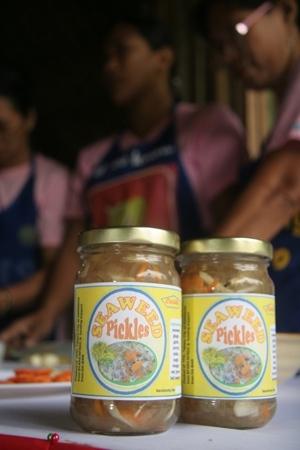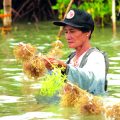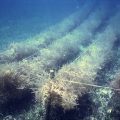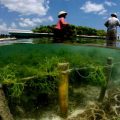During the 7th Agriculture and Fisheries Technology Forum and Product Exhibition organized by the Bureau of Agricultural Research (BAR) in August 2011 at the SM MegaMall in Mandaluyong City, a curious crowd had gathered to watch a cooking demonstration. The two dishes being prepared were spaghetti and leche flan. Now, this may not have looked like anything out of the ordinary save for one thing – the spaghetti and leche flan were made with seaweed! They looked like the real thing. Those who got to taste the dishes said they were good.

Preparing the dishes then were Bureau of Fisheries and Aquatic Resources 5-Regional Fisheries R&D Center (BFAR 5-RFRDC) Manager Aida Andayog and her staff who are based in Sorsogon where the center’s researches on seaweed and seaweed products are conducted. Already, the center has demonstrated that local edible seaweeds can be used to make a variety of food. To date, they have come up with some 20 value-added products from seaweed.
But why use seaweed for everyday food?
To the researchers, the edible seaweeds can substitute for many of our daily dishes. According to Ms. Andayog, “Seaweeds are nutritious. They can help build and sustain the broad nutritional requirements and balance of vitamins, minerals and vital nutrients”. Her team has used them for making pansit/noodles, pickles, morcon, lumpia, chocolate, jam/marmalade and nata de seaweed. Their food potentials continue as they can be used as stabilizer, emulsifier, binder, thickening agent and jelly. They also have applications in medicine and in industry owing to their unique characteristics. They also find use in wastewater treatment, and as animal feed and fertilizer.
Much of man’s civilization developed along the seacoasts and seaweeds have been part of his diet. In Asia, where the use of these plants as food is most developed, particularly Japan, Korea, and China, seaweed cultivation is a major industry. It is eaten as a vegetable in raw or processed form, as a food wrapper, as a cooked rice and dish enhancer, and many others. Presently, in the coastal areas of the Bicol region’s provinces (Camarines Norte, Camarines Sur, Albay, Sorsogon, Catanduanes, and Masbate) where seaweed can grow, many of the communities are engaged in seaweed farming. The Bicol region, particularly the Province of Sorsogon, commercially important seaweeds grow abundantly and include species of Eucheuma, Gracilaria, Caulerpa, Gelidium, and Kappapychus.
Bicol is also rich in marine fish and the region has been processing tuna, snapper, sardines, croakers, siganids, and others for food through traditional sun-drying, smoking (“inagunan”), and fermentation methods. Some are unique to Bicol and the rest of the country is yet to be acquainted with them.
To the residents, these are not just food but they provide much needed extra income. These products have high demand from both local and foreign tourists. The possibility of opening up more livelihood opportunities for fishermen and other workers is a compelling reason for BFAR Region 5 to improve on and expand these cottage industries.
However, for the seaweed and marine food products produced by the coastal communities of Bicol to penetrate a wider market, these need to undergo further product improvement and pass the hurdle of regulations and protocols governing food preparations for safety reasons. Product acceptability among would-be entrepreneurs and the business and marketing side of production also have to be explored.
In 2017, BFAR 5 submitted a proposal to BAR titled, “Technology Enhancement and Utilization of Seaweeds Value-Added and Fishery Products in Bicol Region” to address these concerns. Broadly, the project looked into the production and commercialization of seaweeds and processed fish products with the view of enhancing their viability in the market and creates livelihood opportunities in the coastal communities of the region.
More specifically, it intends to enhance the quality and packaging of processed fish and the production of seaweeds products; test for the nutritional and microbiological contents of the products; and acquire an understanding of their acceptability and the preferences of consumers through market studies in order to make the commercialization of local seaweed and fish products industries viable. To promote livelihood opportunities, the project provided technical assistance and input support to identified groups through demonstrations and trainings on value-added seaweed and fish products.
On the improvement of seaweed value-added products, the project implementers plan to enhance their sensory characteristics (e.g., look, smell, taste, texture) and the quality of packaging and labeling. As for fish products, their processing (drying, smoking, and fermentation) is to be improved with good manufacturing practices (GMP).
The project implementers believe that food safety is a basic consideration. Food coming from the sea has its own hazards. Contaminated and adulterated food can result to illness or worse. For both kinds of products, the application of Sanitation Standard Operating Procedures (SSOP) and Hazard Analysis and Critical Control Points (HACCP), in addition to GMP, was to be conducted to promote food safety and food quality in compliance with the standards set by the Philippine Food and Drug Administration (FDA).
By the end of the project, the implementers accomplished the following: improvements in at least four products – spicy noodles, seaweed sauce, seaweed cookies and marshmallows – in terms of their sensory characteristics, labeling and packaging; the nutritional and microbiological contents of the seaweed and fish products determined; demonstrations on the technologies updated/developed that promote livelihood opportunities for local organizations, out-of-school youth and fisherfolk in at least one site per province in the region conducted; and identified peoples organizations (PO) assisted in linking with LGUs and other appropriate agencies, given trainings on production, and provided with technical assistance on product safety, packaging, promotion, marketing, and related support.
An early participant in BFAR5’s promotion of seaweed value-added products is the Tabaco Faith International Church – Ladies Association in Tabaco, Albay. Now known as the Tabaco Christian Producer Cooperative (TCPC), the organization has been commercially producing seaweed-fortified pansit and other value-added products, such as seaweed pickles and nata de seaweed, using the technologies developed by BFAR5-RFRDC. Its seaweed pansit has reached the cities of Manila and Cebu, and, surprisingly, South Korea. In year 2012 alone, the TCPC turned out 1,200 kg of the product and this has been increasing annually. The TCPC is assisted by BFAR5-RFCDC in the improvement of its processing methods and in the conduct of market studies in order to expand the business.
Other organizations in Bicol have begun to adopt the technologies on seaweed value-added products as well. Some of the members of a PO in Sorsogon could not wait and have gone ahead and are already doing home-based businesses in making seaweed jelly flan, pickles, juice, and ice candy. ###Victoriano B. Guiam
For more information:
Ms. Aida S. Andayog
Project Leader/RFRDC Manager
BFAR 5 RFRDC
Cabid-an, Sorsogon City, Sorsogon
Phone: +63 (054) 228 0839
email: asandayog@yahoo.com or rfrdc5@yahoo.com
Source: https://www.bar.gov.ph




